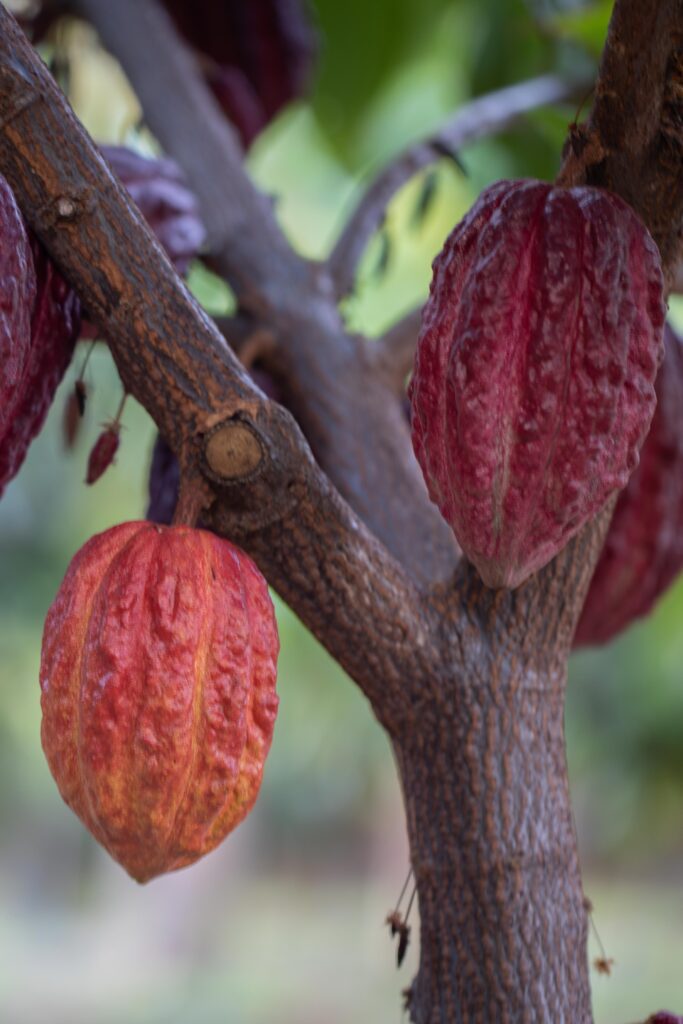The genetic background of Theobroma cacao is complex and consists of numerous wild populations, several domesticated cultivars, traditional varieties/landraces, clonal cultivars propagated through grafting, and mixed hybrid populations.
At least a dozen, genetically distinct, wild populations of cacao still exist in the Amazon and Orinoco river basins but are seldom cultivated.
Three cultivars of cacao have been domesticated by mankind and grow true to type (that is, are highly homozygous) from seed: ‘Criollo’, ‘Ecuadorian Nacional’, and ‘Amelonado’.
There are several traditional varieties or landraces that have some degree of genetic diversity and are not fully domesticated, but have unique attributes and a history of cultivation in certain regions: ‘Piura Blanco’ and ‘Chuncho’ in Peru, and ‘Trinitario’ are examples.
Some traditional varieties and mixed hybrids are clonally propagated by grafting. Examples of common grafted varieties include the Trinitario ICS and UF clones, Ecuadorian Nacional hybrids, and Upper Amazon-Trinitario hybrids such as CCN-51.
Despite the existence of traditional varieties and clonal cultivars, the majority of farmers throughout the world plant hybrid cacao from seed. These hybrid seedlings defy easy categorization because they consist of a mixed genetic background made up of multiple parent populations.
These genetic categories and associated nomenclature are not specific to cacao. However, cacao is unlike most other fruit crops that are typically propagated asexually through grafting or cuttings. Cultivated cacao is propagated with a range of different methods and sources of plant material that have an impact on the resulting genetic structure.
Because of these differences, the genetics of cacao cannot be easily compared to that of other fruit crops.
Próximamente versión en español




Entry added: March 12, 2023
Verified on: September 14, 2023
Authored by
Dan O’Doherty, Consultant/Owner of Cacao Services Inc.
Agricultural Professional
References
“Geographic and Genetic Population Differentiation of the Amazonian Chocolate Tree (Theobroma cacao L),” Juan C. Motamayor, Philippe Lachenaud, Jay Wallace da Silva e Mota, Rey Loor, David N. Kuhn, J. Steven Brown and Raymon J. Schnell, PLoS ONE, 2008
“Genetic identity and origin of “Piura Porcelana” — a fine-flavored traditional variety of cacao (Theobroma cacao) from the Peruvian Amazon,” Enrique Arevalo-Gardini, Lyndel W. Meinhardt, Luis C. Zuñiga, Juan Arévalo-Gardni, Lambert Motilal and Dapeng Zhang, Tree Genetics & Genomes, 2019
The genetic diversity of cacao and its utilization, B. G. D. Bartley, CABI, 2015.
“Insight into the Wild Origin, Migration and Domestication History of the Fine Flavour Nacional Theobroma cacao L. Variety from Ecuador,” Rey Gaston Loor Solorzano, Olivier Fouet, Arnaud Lemainque, Sylvana Pavek, Michel Boccara, Xavier Argout, Freddy Amores, Brigitte Courtois, Ange Marie Risterucci and Claire Lanaud, PLoS ONE, 2012
Have a comment on this definition?
